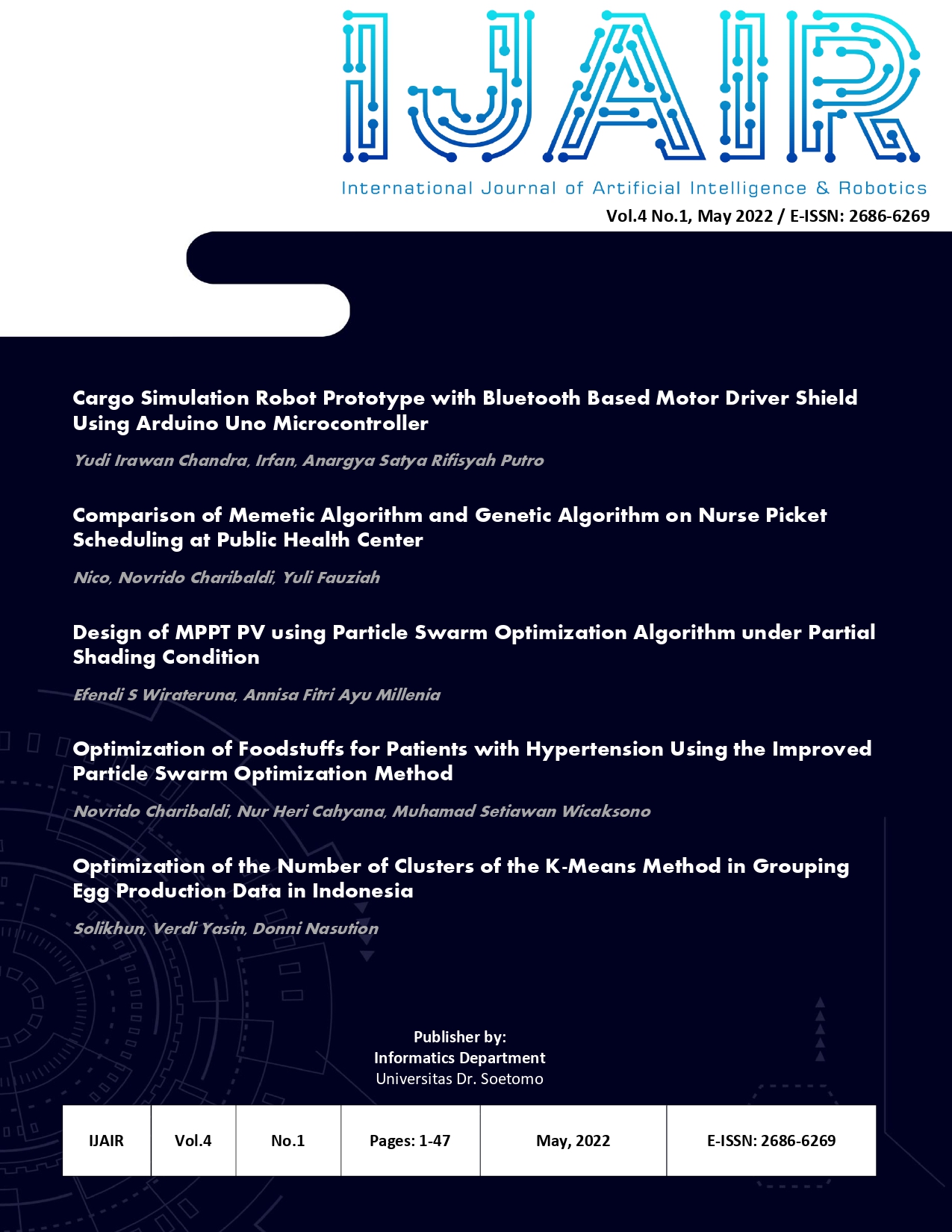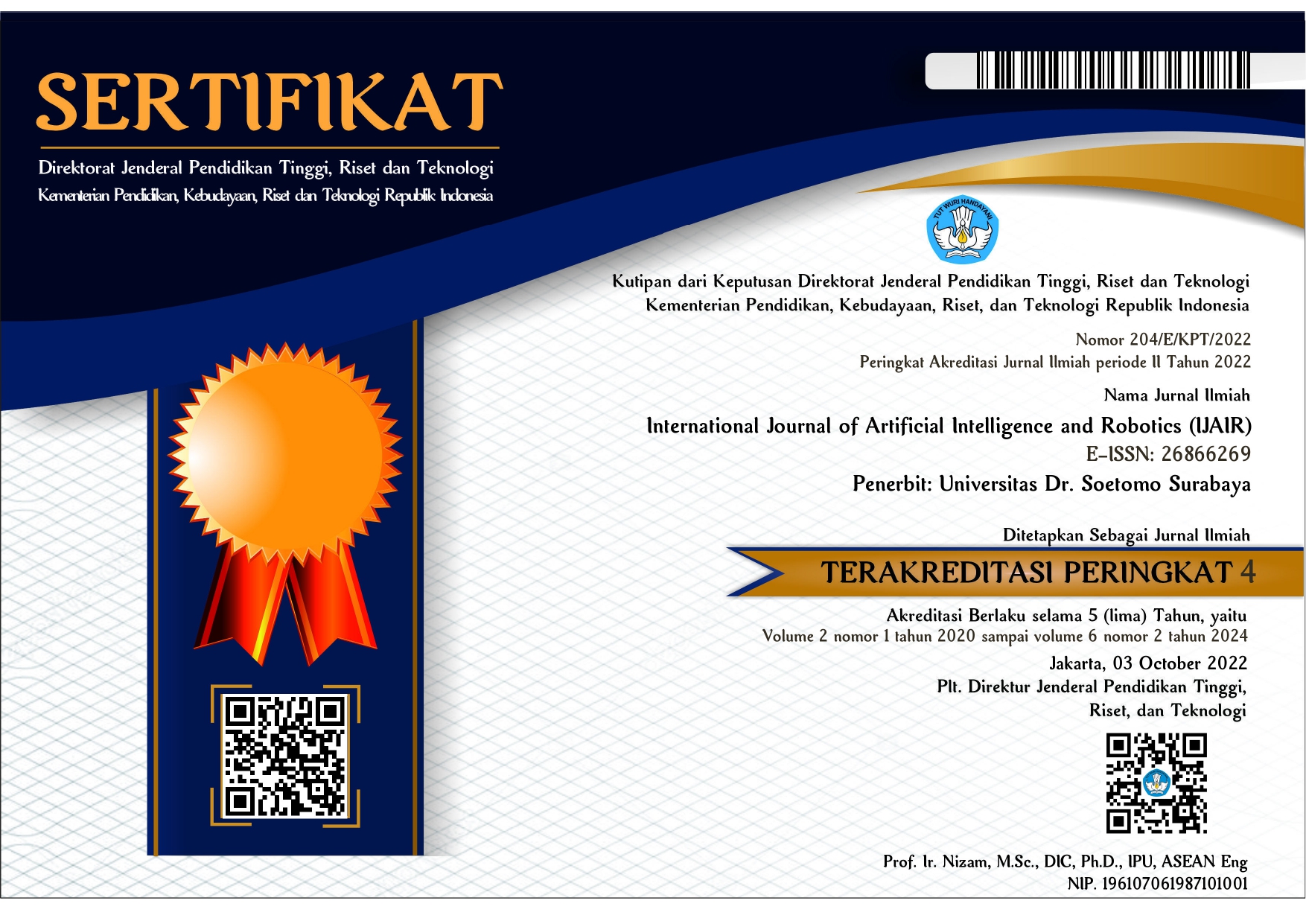Optimization of the Number of Clusters of the K-Means Method in Grouping Egg Production Data in Indonesia
 Abstract views: 517
,
Abstract views: 517
,
 PDF downloads: 391
PDF downloads: 391
Abstract
The need for eggs that continues to increase will not increase with large egg production so that there is a shortage of egg supplies which results in high egg prices. It is necessary to group egg production in Indonesia to find out which areas fall into the high cluster and which areas fall into the low cluster. This study aims to classify the egg production of laying hens in Indonesia. The method used is the K-Means Clustering method which is a popular clustering method. To find out how optimal the number of clusters in the K-Means method is for grouping egg production in Indonesia, the researcher evaluates the DBI value of each number of existing clusters. In this study, 8 clusters were used, namely 2 clusters, 3 clusters, 4 clusters, 5 clusters, 6 clusters, 7 clusters, 8 clusters, and 9 clusters. The results of measuring the DBI value are the number of clusters 2 = 0.215, the number of clusters 3 = 0.149, the number of clusters 4 = 0.146, the number of clusters 5 = 0.157, the number of clusters 6 = 0.180, the number of clusters 7 = 0.205, the number of clusters 8 = 0.192 and the number of clusters 9 = 0.154. This study shows that the best number of clusters is the number of clusters 4 with the smallest DBI value of 0.146.
Downloads
References
R. Setiawan, “PENERAPAN DATA MINING MENGGUNAKAN ALGORITMA K-MEANS CLUSTERING UNTUK MENENTUKAN STRATEGI PROMOSI MAHASISWA BARU ( Studi Kasus : Politeknik LP3I Jakarta ),†vol. 3, no. 1, pp. 76–92, 2016.
N. H. Kristanto, A. C. L. A, and H. B. S, “Implemantasi K-Means Clustering untuk Pengelompokan Analisis Rasio Profitabilitas dalam Working Capital,†Juisi, vol. 02, no. 01, pp. 9–15, 2016.
H. Effendi, A. Syahrial, S. Prayoga, and W. D. Hidayat, “Penerapan Metode K-Means Clustering Untuk Pengelompokan Lahan Sawit Produktif Pada PT Kasih Agro Mandiri,†Teknomatika, vol. 11, no. 02, pp. 117–126, 2021.
Y. H. Susanti and E. Widodo, “Perbandingan K-Means dan K-Medoids Clustering terhadap Kelayakan Puskesmas di DIY Tahun 2015,†Pros. SI MaNIs (Seminar Nas. Integr. Mat. dan Nilai Islam., vol. 1, no. 1, pp. 116–122, 2017.
R. R. Muhima, M. Kurniawan, and O. T. Pambudi, “A LOF K-Means Clustering on Hotspot Data,†Int. J. Artif. Intell. Robot., vol. 2, no. 1, p. 29, 2020.
M. Kurniawan, R. R. Muhima, and S. Agustini, “Comparison of Clustering K-Means, Fuzzy C-Means, and Linkage for Nasa Active Fire Dataset,†Int. J. Artif. Intell. Robot., vol. 2, no. 2, p. 34, 2020.
M. Z. Sarwani, D. A. Sani, and F. C. Fakhrini, “Personality Classification through Social Media Using Probabilistic Neural Network Algorithms,†Int. J. Artif. Intell. Robot., vol. 1, no. 1, p. 9, 2019.
R. Hariyanto and M. Z. Sarwani, “Optimizing K-Means Algorithm by Using Particle Swarm Optimization in Clustering for Students Learning Process,†Inf. J. Ilm. Bid. Teknol. Inf. dan Komun., vol. 6, no. 1, pp. 65–68, 2021.
I. Ruslianto, “PUYUH MENGGUNAKAN METODE CONNECTED,†vol. 3, no. 1, pp. 41–50, 2013.
E. G. Sihombing, “KLASIFIKASI DATA MINING PADA RUMAH TANGGA MENURUT PROVINSI DAN STATUS KEPEMILIKAN RUMAH KONTRAK / SEWA MENGGUNAKAN K-MEANS CLUSTERING METHOD,†vol. 2, no. 2, pp. 74–82, 2017.
E. Nanda, Solikun, and Irawan, “PENERAPAN DATA MINING DALAM MENGELOMPOKAN PRODUKSI JAGUNG MENURUT PROVINSI MENGGUNAKAN ALGORITMA K-MEANS,†vol. 3, pp. 702–709, 2019.
I. F. Ashari, R. Banjarnahor, and D. R. Farida, “Application of Data Mining with the K-Means Clustering Method and Davies Bouldin Index for Grouping IMDB Movies,†vol. 6, no. 1, pp. 7–15, 2022.
N. Suryana, “Penggunaan metode statistik K-Means clustering pada analisis peruntukan lahan usaha tambang berbasis sistem informasi geografi,†J. Teknol. Miner. dan Batubara, vol. 7, no. 1, pp. 42–53, 2011.
E. Muningsih, “Optimasi Jumlah Cluster K-Means Dengan Metode Elbow Untuk Pemetaan Pelanggan,†Pros. Semin. Nas. ELINVO, no. September, pp. 105–114, 2017.
D. Jollyta, S. Efendi, M. Zarlis, and H. Mawengkang, “Optimasi Cluster Pada Data Stunting: Teknik Evaluasi Cluster Sum of Square Error dan Davies Bouldin Index,†Pros. Semin. Nas. Ris. Inf. Sci., vol. 1, no. September, p. 918, 2019.
E. Muningsih, I. Maryani, and V. R. Handayani, “Penerapan Metode K-Means dan Optimasi Jumlah Cluster dengan Index Davies Bouldin untuk Clustering Propinsi Berdasarkan Potensi Desa,†J. Sains dan Manaj., vol. 9, no. 1, pp. 95–100, 2021.
R. K. Dinata, H. Novriando, N. Hasdyna, and S. Retno, “Reduksi Atribut Menggunakan Information Gain untuk Optimasi Cluster Algoritma K-Means,†J. Edukasi dan Penelit. Inform., vol. 6, no. 1, p. 48, 2020.
Copyright (c) 2022 Solikhun Solikhun

This work is licensed under a Creative Commons Attribution-ShareAlike 4.0 International License.
Authors who publish with International Journal of Artificial Intelligence & Robotics (IJAIR) agree to the following terms:
-
Authors retain copyright and grant the journal right of first publication with the work simultaneously licensed under a Creative Commons Attribution License (CC BY-SA 4.0) that allows others to share the work with an acknowledgment of the work's authorship and initial publication in this journal.
-
Authors are able to enter into separate, additional contractual arrangements for the non-exclusive distribution of the journal's published version of the work (e.g., post it to an institutional repository or publish it in a book), with an acknowledgment of its initial publication in this journal.
-
Authors are permitted and encouraged to post their work online (e.g., in institutional repositories or on their website) prior to and during the submission process, as it can lead to productive exchanges, as well as earlier and greater citation of published work.















